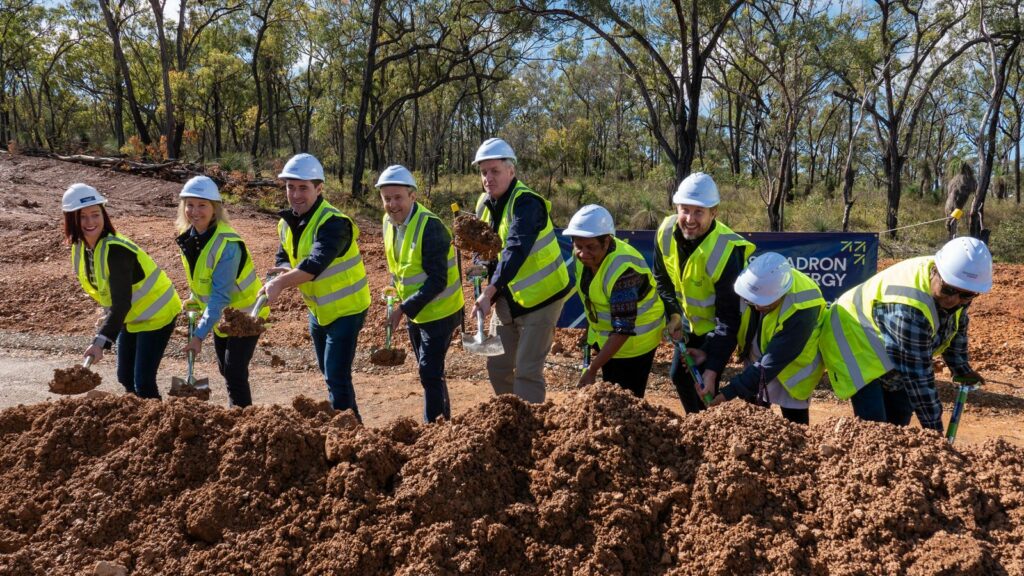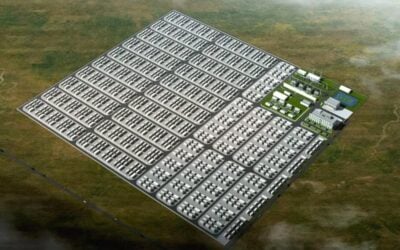
Construction has begun on a large-scale hybrid renewable energy project combining wind, solar PV and energy storage in Australia, while another has been announced in Wales.
Squadron Energy, a renewable energy firm owned by Australian billionaire Dr Andrew ‘Twiggy’ Forrest’s Tattarang group, said earlier this month that construction has begun on the first phase at Clarke Creek Wind, Solar and Battery Farm in Queensland.
Enjoy 12 months of exclusive analysis
- Regular insight and analysis of the industry’s biggest developments
- In-depth interviews with the industry’s leading figures
- Annual digital subscription to the PV Tech Power journal
- Discounts on Solar Media’s portfolio of events, in-person and virtual
An initial 100 turbines capable of generating 450MW of wind power is being installed at the site between the cities of Mackay and Rockhampton near Queensland’s coast in the northeast of Australia.
While that capacity will begin generating by 2025 and selling electricity to state government-owned power company Stanwell for 15 years through a 346.5MW power purchase agreement (PPA), plans are to add 400MW of solar PV, bring the wind power capacity up to 800MW in total and add battery energy storage system (BESS) technology.
Stage 1 of the project alone is expected to bring A$100 million (US$67.57 million) investment to the local economy, creating about 350 construction-stage jobs. Development approvals were granted for the solar and wind power in 2018.
Energy-Storage.news has sent an enquiry to Squadron asking for the planned sizing and capacity of the battery storage system at the hybrid plant but had not received a reply at time of publication.
Australia is currently planning its phase out of coal which provides the majority of baseload energy to the grid and modelling by the Australian Energy Market Operator (AEMO) has shown that renewable energy paired with battery storage, along with some gas generation, will be the most important tools available to manage that decline, maintain reliability while suppressing cost increases and attain the country net zero emissions status by 2050.
Twiggy Forrest has been an enthusiastic advocate and investor in renewable energy technologies, not only to power the many mining and extraction operations of his main business holding, Fortescue Metals, but also to provide and sell power on the market.
This has included establishment of Fortescue subsidiaries focused on green and distributed energy technologies like green hydrogen and microgrid development. For example, Fortescue Future Industries is currently planning Uaroo Renewable Energy Hub, a project in Western Australia’s Pilbarra region which could be up to 5.4GW of wind and solar with 9.1GWh of batteries, designed to power Fortescue’s mining operations.
Squadron Energy is owned by the Forrest family’s private investment group Tattarang. Squadron is involved in the Sun Cable project which aims to transmit solar PV-generated electricity from Australia to Singapore.
“We will deliver affordable energy for Australian families and industry without destroying the environment like carbon emitting fuels do,” Forrest said in his capacity as Tattarang chairman.
“When fully operational, Clarke Creek will displace enormous amounts of carbon each year by harnessing the renewable energy of the wind and sun to power our homes and commercial premises, providing cheaper energy without the hidden costs associated with coal-fired power stations.”
Squadron Energy believes large hubs which deliver firmed power through leveraging energy storage are crucial to enabling the uptake of renewable energy capacity needed to decarbonise Australia, the company’s chairman John Hartmann said.
Meanwhile electrification of sectors like transport and industry increase demand for electricity at the same time and Hartmann pointed out that Queensland has a good combination of sunshine during the day and wind at night.
Birth of the true hybrids
Elsewhere, as reported by our colleagues at sister site Solar Power Portal at the beginning of this week, EDF is planning Hirfynydd Renewable Energy Park, a hybrid wind-solar-battery project of its own in Wales, UK.
Subsidiary EDF Renewables wants to develop the 100MW site in the southwestern Welsh county borough of Neath Port Talbot. The company did not offer a breakdown of what each different technology would contribute to the figure but did say the initial phase will involve construction of seven wind turbines.
The development arm of the French energy giant said a breadth of technologies would increase the site’s generation potential while the battery storage element would allow it to store surplus energy and provide grid balancing services.
“Hirfynydd would make a positive contribution to our efforts to tackle climate change and at a time of global uncertainty over energy supply and costs, renewable energy projects are vital to dealing with these challenges,” said Simon Morgan, principal project development manager at EDF Renewables UK.
EDF Renewables is currently carrying out early ecological and other feasibility studies at the site, with events planned in September to share more details of the development with the local communities in nearby Crynant and Seven Sisters.
In the next couple of months, the company will submit its scoping report to Planning and Environmental Decisions Wales as well as an application to erect a meteorological mast to Neath Port Talbot County Council.
The company hopes to submit a planning application for Hirfynydd Renewable Energy Park by the end of 2023. This will be assessed Planning and Environmental Decisions Wales and a final decision on its approval taken by the Welsh Government.
According to EDF’s website, it hopes to have the whole site commissioned in the 2027-2028 timeframe.
While these projects will be generating wind and solar PV energy and storing and dispatching it with battery storage at large-scale within the next few years, a very small number of such projects already exist already.
Utility Vattenfall opened the hybrid Energypark Haringvliet in the Netherlands, Europe, earlier this year. It combines 38MW of solar PV with 22MW of wind turbines and a 12MWh BESS, in a project which cost about €61 million (US$61 million).
At a similar scale to Forrest’s Clarke Creek project is another hybrid in Australia. Work begin in January this year on Goyder Renewables Zone, in South Australia. Developer Neoen has been granted permission to build a total 1,200MW of wind power generation, 600MW of solar PV and 900MW of BESS at the site.
In Chile, last year Engie won government contracts to build two hybrid wind-solar-storage projects with a combined generation capacity of 1.5GW.
EDF-Hirfynydd Renewable Energy Park story, with reporting by Molly Lempriere, first appeared on Solar Power Portal.






